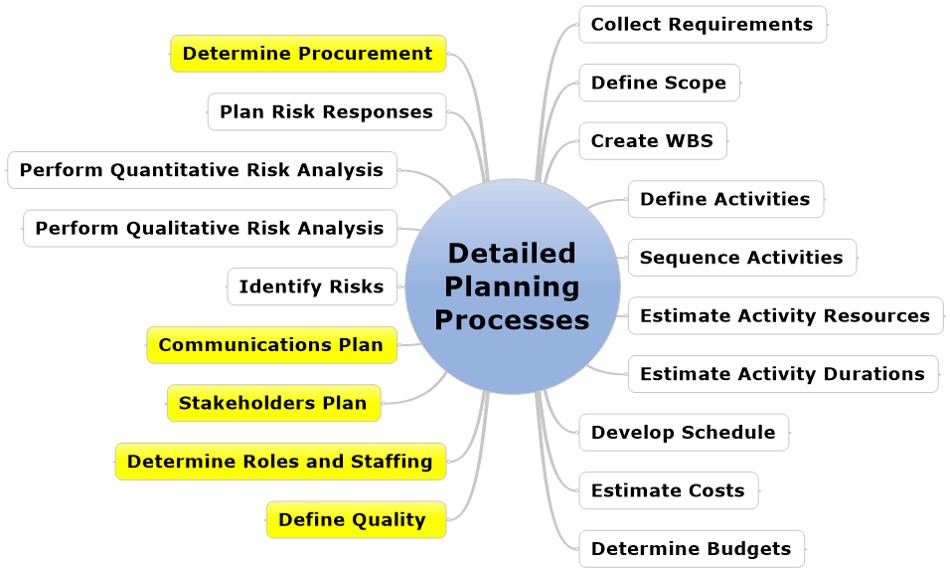This is the third article in a 3-article series on project / stage / phase planning. It is also from a new book that we are working on.
The first article covered the need to have two distinct plans instead of one for every stage. The second article addressed the management planning and the need for a stage management plan. Today, we cover the stage detailed planning.
PMBOK® Guide Perspective
There are fourteen detailed planning processes; out of the twenty-four in the planning process group. For a listing of these processes, please refer to the PMBOK® Guide and the figure (excluding those highlighted in yellow).

However, it would be beneficial to have more processes.
The author believes that some of the processes in the PMBOK® Guide should be split, since they include elements of both sub-groups. This is not limited to planning, but will leave that discussion for another book.
For example: “Plan Quality Management” includes ‘how to’ topics; like how to plan, manage, perform quality assurance, and control quality. Further, this process includes ‘doing’ such as identifying the quality standards that apply to the stage and what need to be done to achieve compliance. In other words, these are detailed planning activities.

Therefore, it is suggested that there should be a “Plan Quality Management” process focusing on the management of quality on the stage or project, and a ‘Define Quality’ process which include the standards and how to comply with them. Figure 15 illustrates the revised quality function, which would consists of four processes, instead of three.
 Other processes that should be split, in a similar fashion to quality, are human resources, communication, stakeholders, and procurement[1] since all of them include the ‘doing’ ‘implicit processes’ with the management planning processes.
Other processes that should be split, in a similar fashion to quality, are human resources, communication, stakeholders, and procurement[1] since all of them include the ‘doing’ ‘implicit processes’ with the management planning processes.
CAM2P™ Perspective
Per the CAM2P™ standard model, detailed planning consists of:
- The fourteen dedicated detailed planning processes from the PMBOK® Guide.
- Other detailed planning ‘implicit processes’ that should be split from the management planning processes; for quality, human resource, stakeholders, communication, and procurement areas.
- Other detailed planning processes that are not in the guide, such as safety, health, environmental, sustainability, and others that might be domain specific.
 Table 3 presents the template for a typical stage detailed plan. It includes all the processes listed above. Unlike the Stage Management Plan, the detailed plan could be significant and requires more effort and time.
Table 3 presents the template for a typical stage detailed plan. It includes all the processes listed above. Unlike the Stage Management Plan, the detailed plan could be significant and requires more effort and time.
Project |
Phase / Stage |
Scope of Work & WBS[3] |
Define Quality[4] |
Safety, Health, Environment |
Sustainability |
Time Estimate (Schedule)[5] |
Cost Estimate |
Budget and Time Phased Budget |
Human Resources[6] |
Stakeholders |
Communications |
Risk Management[7] |
Procurement |
Other Considerations |
The above content is from an upcoming book on how to apply a project life cycle methodology, incorporating the PMBOK process groups, on a large and complex project.
[1] The author has been working on a book about the PMBOK® Guide, where he addresses the guide from a continual improvement perspective, including suggestions for changes and modifications, such as what is mentioned here.
[2] In this table, red font is for items not in the PMBOK® Guide and items in brown font are in the guide but without a dedicated process.
[3] Include all scope detailed planning processes.
[4] Per earlier discussion, this is split out from the “Plan Quality Management” process. In the stage management plan we include the general process for managing quality on the stage but here we include the detailed quality planning activities.
[5] Include all time management detailed planning processes.
[6] Roles and Responsibilities and Staffing Plan for the team that will perform the stage work (executing).
[7] Includes all risk management detailed planning processes.

